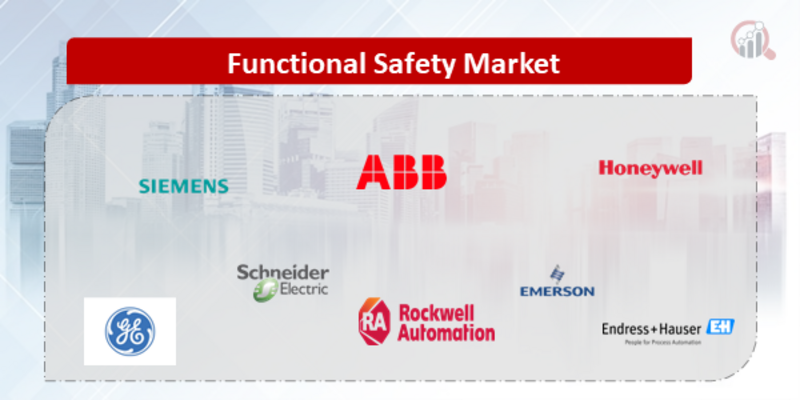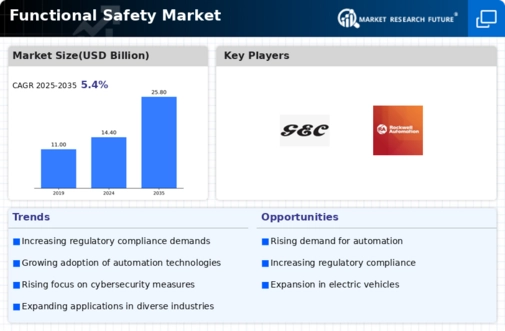Top Industry Leaders in the Functional Safety Market

The Competitive Landscape of the Functional Safety Market
The functional safety market, plays a critical role in ensuring the safe operation of complex systems across various industries. From the blink of an airplane landing gear to the intricate dance of an automated assembly line, functional safety systems act as vigilant guardians, minimizing risks and preventing unforeseen hazards. Understanding the competitive landscape in this dynamic market is crucial for players seeking to secure their share in safeguarding our world.
Some of the Functional Safety companies listed below:
- Siemens AG
- ABB Ltd.
- Honeywell
- General Electric Co.
- Schneider Electric SE
- Rockwell Automation inc.
- Emerson Electric Co.
- Honevwell International inc.
- HIMA Paul Hildebrandt GmbH
- Endress+Hauser Management AG
- TUV Rheinland
- Omron Corporation
- Yokogawa Electric Corporation
- DEKRA Group
Strategies Adopted by Leaders
- Technological Prowess: Leading players like Siemens, Honeywell, and ABB invest heavily in R&D, pushing boundaries in safety technologies, risk assessment methodologies, and advanced control systems. They pioneer technologies like machine learning-powered anomaly detection, self-aware safety systems, and predictive maintenance algorithms, offering enhanced risk mitigation and improved operational reliability.
- Industry Focus: Players cater to specific industry segments with unique safety requirements. Rockwell Automation excels in manufacturing safety solutions, while Emerson Electric focuses on oil and gas industry applications. This specialization allows for deep domain expertise and tailored safety solutions for each sector's distinct risks.
- Compliance Expertise: Navigating the complex web of safety regulations and standards is essential. Companies like TÜV SÜD and Exida provide consulting and certification services, helping organizations comply with relevant safety standards and achieve regulatory approval.
- Integrated Safety Solutions: Offering comprehensive safety packages encompassing risk assessment, safety planning, and system implementation creates a one-stop solution for customers. Companies like Schneider Electric and Eaton provide holistic safety solutions, simplifying the safety implementation process.
- Strategic Partnerships: Collaborations with technology providers, research institutions, and system integrators accelerate innovation and broaden market reach. For instance, partnerships between safety solution providers and sensor manufacturers enable seamless integration of safety systems into existing infrastructure.
Factors for Market Share Analysis:
- Safety Technology: Analyzing market share by safety technology (safety controllers, PLCs, safety relays) reveals dominant players in each segment and future growth potential. Programmable logic controllers (PLCs) with integrated safety functionalities remain popular, while advanced safety technologies like formal verification tools are gaining traction.
- Industry Application: Understanding the needs of different end-user segments (automotive, aerospace, healthcare) is key. Automotive safety prioritizes real-time response and redundancy, while aerospace applications demand extremely high reliability and fail-safe mechanisms.
- Compliance Standards: Adherence to relevant safety standards (ISO 26262, IEC 61508) is critical for market acceptance and competitive advantage. Players who demonstrate expertise in specific standards cater to niche markets with stringent safety requirements.
New and Emerging Companies:
- GuardKnox: This Israeli company utilizes blockchain technology to create tamper-proof safety records and audit trails, addressing the growing need for cybersecurity in safety-critical systems.
- Cybernetica: This Belgian company specializes in formal verification tools for safety-critical software, offering rigorous mathematical proof of software reliability and reducing risk of system failure.
- Precognis: This American company pioneers risk assessment software utilizing artificial intelligence and machine learning, enabling predictive identification of potential hazards and proactive risk mitigation strategies.
Industry Developments:
A new functional safety robot control solution will be introduced in 2023, according to NexCOBOT and its ecosystem partners, who will make the announcement at Hannover Messe 2023. The SCB100 PC-based robot control platform from NexCOBOT, the smart servo drive from Synapticon, and the safe motion module from Synapticon combine to create the next-generation modularized collaborative application robot control ROBASafe solution, which is the first x86 SIL 2/SIL 3 robot control solution in the world.
For its RA and RX Families of microcontrollers, Renesas Electronics Corporation has introduced new functional safety solutions in 2022 that adhere to the IEC61508 standard. Renesas now provides Arm Cortex-M23 and -M33-based MCUs with IEC 61508 SIL3 approved self-test software. The IEC 61508 SIL3 certified PROFIsafe Application Software for RX MCUs was also made public by Renesas. Renesas is the first semiconductor manufacturer in the market to provide these solutions.
2019 will see the expansion of TÜV SÜD America Inc.'s comprehensive Functional Safety Testing Services. TÜV SÜD America Inc. is a premier provider of quality, safety, and sustainability solutions with a focus on testing, inspection, auditing, certification, training, and knowledge services.








